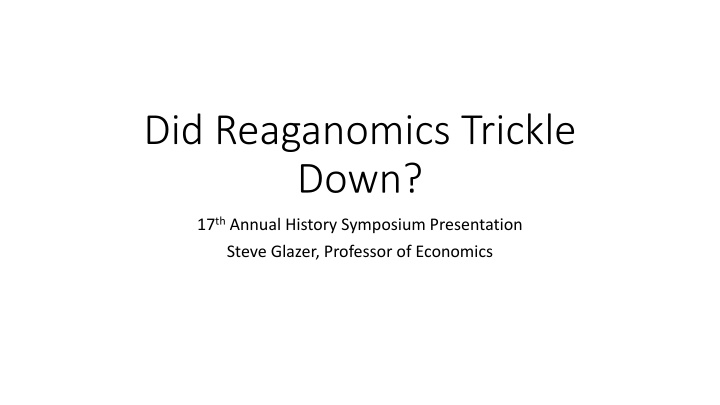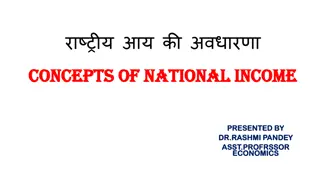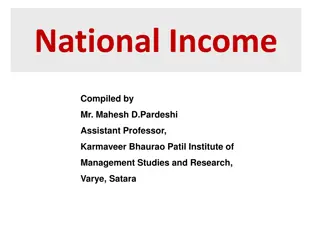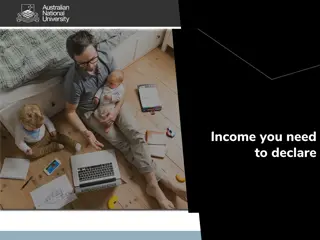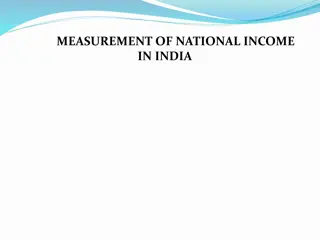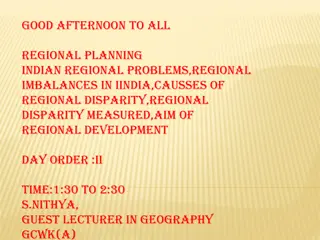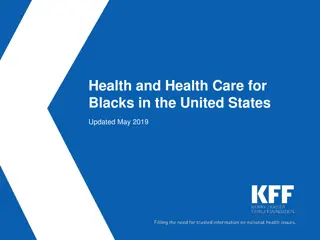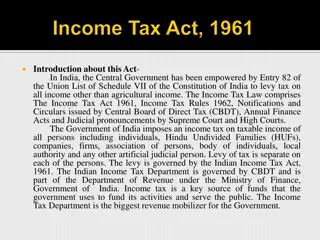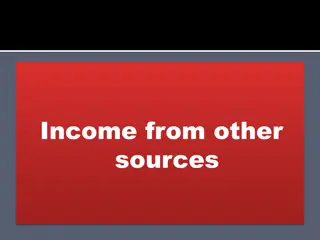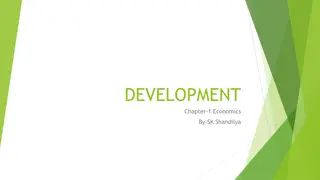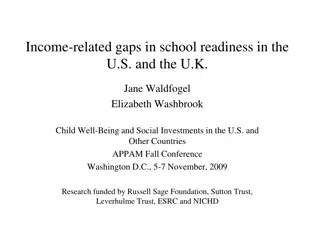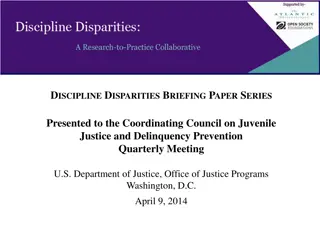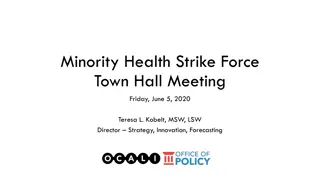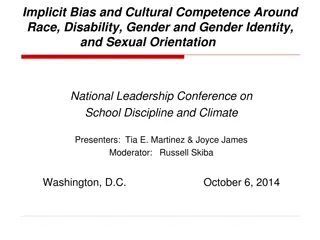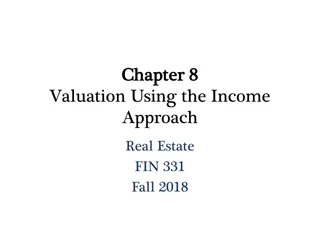Reaganomics Impact on Income Disparities and Economic Policies
Reaganomics, introduced during the 1980s by President Reagan, aimed to address economic challenges through tax cuts, decreased social spending, increased military spending, and deregulation. While the top tax rates were significantly reduced, disparities emerged as lower and middle-income groups faced increased payroll and excise taxes. The policies led to a shift in income distribution favoring the wealthy, sparking debates on the effectiveness of trickle-down economics and its impact on societal divisions.
Download Presentation

Please find below an Image/Link to download the presentation.
The content on the website is provided AS IS for your information and personal use only. It may not be sold, licensed, or shared on other websites without obtaining consent from the author.If you encounter any issues during the download, it is possible that the publisher has removed the file from their server.
You are allowed to download the files provided on this website for personal or commercial use, subject to the condition that they are used lawfully. All files are the property of their respective owners.
The content on the website is provided AS IS for your information and personal use only. It may not be sold, licensed, or shared on other websites without obtaining consent from the author.
E N D
Presentation Transcript
Did Reaganomics Trickle Down? 17thAnnual History Symposium Presentation Steve Glazer, Professor of Economics
Background 1970 s: Stagflation period of high unemployment combined with high rates of inflation and wage stagnation, thereby leading to a stagnant, or slow growth, economy, as household purchasing power decreased. This was seen in many industrialized nations worldwide. Oil embargo of 1973-1974 followed by the oil crisis in 1979 led to an energy shock, which due to the decreased supply of oil, contributed to the aforementioned inflation, as oil prices skyrocketed. As quickly as these prices rose, they took a long while, the better part of the 1980 s, to decrease.
1980 Presidential Election Economic Issues Double Digit Inflation Rising Unemployment Impact of Big Government on the economy as candidate Reagan portrayed the actions of President Carter s administration as causing the size of government to become larger and more involved in all aspects of the lives of American citizens Candidate Reagan called for tax cuts to address the economic woes of the nation Candidate Reagan was successful in his bid for the presidency
President Reagan Economic Policies Four main principles Tax cuts Decreased social spending Increased military spending Deregulation of domestic markets
Tax Changes Reaganomics called for reduced taxes for individuals, businesses, and investments. Top tax rate on the wealthiest households was reduced from 70% in 1980 to 50% in 1982. It was then lowered to 38.5% in 1987 and decreased all the way down to 28% in 1988. For the lowest income earners, the tax rate was reduced from 14% to 11%. Corporate tax rate was reduced from 48% to 34% during the Reagan presidency. Capital gains taxes were also reduced from 28% to 20%, benefitting the wealthiest individuals, but this rate reverted back to 28% in 1986.
Tax Cut Disparities on Different Income Levels Despite the previously mentioned tax cuts, Reaganomics called for increasing payroll taxes, like those on Social Security, as well as excise taxes, which are taxes on alcohol, tobacco, and gasoline. As a percentage of income, these increased taxes hurt the lower and middle classes more than they did the wealthiest individuals. As tax rates were lowered on those earning the highest incomes, it meant that not only could the wealthiest Americans keep a larger fraction of the income earned in a given year, but also that their savings would compound at a faster rate.
Laffer Curve Reaganomics is based upon what is called the Laffer Curve, developed by economist Arthur Laffer in 1974. The curve showed how tax cuts could stimulate the economy, so as to expand the tax base and increase government revenue. This will occur in the Prohibitive range, as seen by the curve on the next slide. The issue though is that it cannot be determined at what tax rate the government revenues are in fact maximized. Conversely, government revenues increase from the point of origin up to a point, and after that point, which is in the Prohibitive range, as tax rates continue to increase, it serves as a disincentive to work, as workers take home less, causing the government to receive lower tax revenues.
Supply- Side Economics/Trickle-Down Theory Argues that a decrease in taxes, especially on corporations and the wealthy, will trickle down to the middle and lower classes, since as per the Laffer Curve, companies will respond to lower tax rates by increasing employment . According to the theory, lower taxes are supposed to encourage economic expansion and broaden the tax base over time. The increased revenue from a stronger economy is supposed to offset the initial loss of tax revenue experienced when tax rates decline. These decreased taxes allow the wealthy to have a higher disposable income, or after-tax income, that can then be used for consumption purposes in the economy. A similar rationale holds for corporations, who with lower corporate income taxes, can use these savings to purchase more equipment, hire more workers, and innovate in order to grow their business. More workers mean higher incomes for additional people that will contribute to increased spending throughout the economy. The tax cuts would also serve to incentivize workers to work more hours since they took home a higher disposable income. This would also serve to encourage more individuals to enter the labor force and supply labor to business.
Economic Growth The increased spending on the part of both the household and business, it was argued, would contribute to economic growth. This is based upon data that consistently show that consumption spending, which is the biggest contributor to Gross Domestic Product, or more commonly GDP (between 67% and 70% of GDP), would rise. GDP growth is the metric used to measure the level of economic growth in any economy. Based upon the decrease in the tax rate to 50% in 1982, economic growth, as measured by GDP, rose by 4.5% in 1983, 7.2% in 1984, and 4.1% in 1985. It then stabilized at 3.46% in 1986, followed by another 3.46% increase in 1987, before increasing by 4.1% in 1988. All the while, the unemployment rate trended downward throughout the Reagan presidency, leading to increased spending and the aforementioned increased rates of growth for the economy.
Reduced Government Spending Spending on domestic programs was to be reduced. During his first year in office, President Reagan cut spending on domestic programs by $39 billion. Cuts were made to the following government departments: Commerce, Education, Energy, Interior, and Transportation. Specifically, between 1980 and 1983, the budget category of education, training, employment and social services fell from $32 billion to $27 billion. This category tends to affect the lower and middle classes more than the wealthiest individuals.
Military Spending and Impact on Federal Budget Counteracting the reduced domestic spending was the increased spending geared towards the military, which increased an average of 11% per year under the Reagan presidency from $154 billion in 1981 to $295 billion when he left office. Overall spending rose by 9% per year, compared to a 16% annual increase under President Carter. Spending increased from $678 billion when President Reagan entered office to $1.1 trillion in his last year. This led to a budget deficit and increased the national debt. Upon entering office in 1981, the national debt was $981 billion. By 1989, the national debt had nearly tripled to $2.857 trillion.
Deregulate business Another component of Reaganomics continued the deregulation policies introduced under the presidency of his predecessor, Jimmy Carter. Eliminated price controls on oil and natural gas, long distance telephone services, cable television, interstate bus service, and ocean shipping. Eased regulations on the banking sector.
Tax Revenues and Purchasing Power 1980 tax revenues were $517 billion. 1988 tax revenues were $909 billion. While tax revenues rose throughout the Reagan presidency, the amount paid by the wealthiest individuals declined. Inflation dropped to 4% and the unemployment rate fell to below 6%. While unemployment declined during the Reagan presidency, the real hourly wage, the wage level after inflation is taken into consideration, for nonsupervisory workers declined throughout his administration, signifying that the average worker had less purchasing power, despite inflation rates declining as well. Such individuals fall below the level of management, thereby signifying that the middle and lower classes were adversely affected by the Reagan tax policies.
Poverty Numbers and Rates in the 1980s Number below the poverty line (in thousands) Year Poverty Rate (percentage) 1980 29,272 13.0 1981 31,822 14.0 1982 34,398 15.0 1983 35,303 15.2 Source: U.S. Census Bureau, Current Population Survey, 1960 to 2020 Annual Social and Economic Supplements (CPS ASEC). 1984 33,700 14.4 1985 33,064 14.0 1986 32,370 13.6 1987 32,221 13.4 1988 31,745 13.0 1989 31,528 12.8
Poverty Rates The preceding slide slows that while the poverty rate and number of individuals falling below the poverty level were comparable at the beginning and end of the 1980 s, there was an increase during the first three years of the Reagan administration, with a gradual decline thereafter. This shows the impact of things like the decrease in domestic programs passed at the start of the Reagan presidency. After 1983, these numbers began to improve, as the percentage recovered to the 1980 level, but the overall number of individuals falling below the poverty line was higher at the end of the decade than it was at the beginning of the decade.
Percentage of Income Received by Quintile Shares of aggregate income Year Lowest fifth Second fifth Third fifth Fourth fifth Highest fifth Top 5 percent 1989 3.8 9.5 15.8 24.0 46.8 18.9 1988 3.8 9.6 16.0 24.2 46.3 18.3 1987 3.8 9.6 16.1 24.3 46.2 18.2 1986 3.8 9.7 16.2 24.3 46.1 18.0 1985 3.9 9.8 16.2 24.4 45.6 17.6 1984 4.0 9.9 16.3 24.6 45.2 17.1 1983 4.0 9.9 16.4 24.6 45.1 17.0 1982 4.0 10.0 16.5 24.5 45.0 17.0 1981 4.1 10.1 16.7 24.8 44.3 16.5 1980 4.2 10.2 16.8 24.7 44.1 16.5
Percentage of Income Received by Quintile (continued) From the preceding slide, one can see that the only quintile to see a growing percentage of income received was the top 20%, while the top 5%, specifically saw an increase in the percentage of the aggregate income received. The bottom 60% saw a decrease in the percentage of income received every year from 1980-1989.
Assessment These slides lead to the question of whether the changes in the tax structure, mainly the tax cuts for the highest income earners and businesses, did in fact trickle down. One of the ideals of the Laffer Curve is that the decreased tax rates would increase hiring, and the unemployment data for the decade verify this. However, counteracting this is the decrease in purchasing power for many, especially in the lower and middle classes, despite inflation rates declining. The only group to see an increase in aggregate income was the top 20%, and more specifically the top 5% of income earners. While the poverty rate did decline between 1980 and 1989, there was a spike between 1980 and 1983 indicating once again that the poorest individuals were not reaping the benefits of these tax cuts on the wealthy. Therefore, while the theory shows that all Americans served to benefit from Reaganomics, it is apparent that the wealthiest gained the most from these policies, while the poor and middle classes did not see any significant improvements in their standard of living during the decade.
Thank you! Thank you! Thank you to all of you for reading through this presentation. Thank you to my fellow presenters. A special thank you to Professor Steven Berizzi for organizing this virtual History Symposium.
